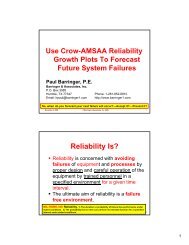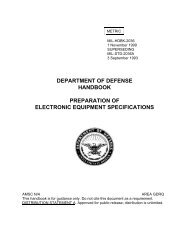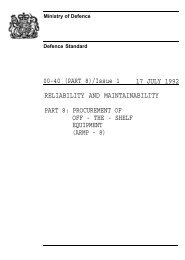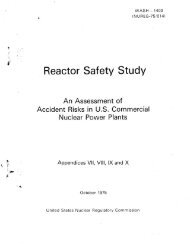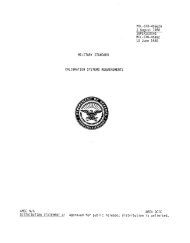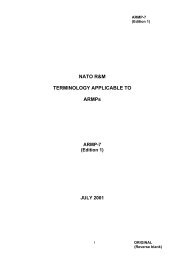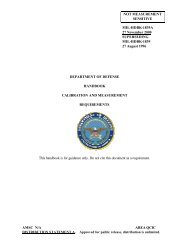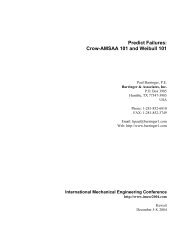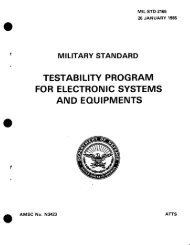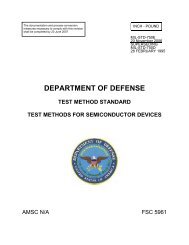MIL-STD-1629-RevA - Barringer and Associates, Inc.
MIL-STD-1629-RevA - Barringer and Associates, Inc.
MIL-STD-1629-RevA - Barringer and Associates, Inc.
You also want an ePaper? Increase the reach of your titles
YUMPU automatically turns print PDFs into web optimized ePapers that Google loves.
.M17,-STW<strong>1629</strong>Athe analysis results to pro~ide design guidance. Worksheet formats,ground rules, analysis assumptions, identification of the lowest indenturelevel of analysis, coding system description, failure definitions, <strong>and</strong>identification of coincident use of the FMECA by the contractor’s reliabilityorganization <strong>and</strong> other organizational elements shall be considered inthe F’KECAplanning.4.3.1 Worksheet formats. The contractor’s formats, whichorganize <strong>and</strong> document the FMECA <strong>and</strong> other analysis methods containedherein, shall include the information shown in the example formats inFigures 101.3, 102.1, 103.1 <strong>and</strong> 104.1. The initial indenture level ofanalysis shall be identified (item name) on each worksheet, <strong>and</strong> eachsuccessive indenture level shall be documented on a separate worksheetor group of worksheets.4.3.2 Ground rules <strong>and</strong> assumptions. The contractor shalldevelop ground rules <strong>and</strong> analysis assumptions. The ground rules shallidentify the FMECA approach (e.g. , hardware, functional or combination),the lowest indenture level to be analyzed, <strong>and</strong> include general statementsof what constitutes a failure of the item in terms of performance criteria<strong>and</strong> allowable limits. Every effort should be made to identify <strong>and</strong>record all ground rules <strong>and</strong> analysis assumptions prior to initiation ofthe analysis; however, ground rules <strong>and</strong> analysis assumptions may beadded for any item if requirements change. Additional ground rules <strong>and</strong>analysis assumptions shall be documented <strong>and</strong> separately identified forinclusion in the FMECA report.4.3.3 Indenture level. The indenture level applies to thesystem hardware or functional level at which failures are postulated.Unless otherwise specified, the contractor shall establish the lowestindenture level of analysis using the following guidelines:a. The lowest level specified in the LSA c<strong>and</strong>idate listto assure complete inputs for each LSA c<strong>and</strong>idate.b. The lowest indenture level at which items are assigneda catastrophic (Category I) or critical (CategoryII) severity classification category (see 4.4.3).c. The specified or intended maintenance <strong>and</strong> repairlevel for items assigned a marginal (Category ITT)or minor (Categorv IL’)severity classificationcategory (see 4.4.3).4.3.4 Coding system. For consistent identification of systemfunctions <strong>and</strong> equipment <strong>and</strong> for tracking failure modes, the contractorshall adhere to a coding system based upon the hardware breakdown structure,work unit code numbering system of <strong>MIL</strong>-<strong>STD</strong>-780, or other similar uniformnumbering system. The coding system shall be consistent with the reliability<strong>and</strong> functional block diagram numbering system to provide complete visibilityof each faililr[;mode arid j1% rc,l,tt jI_II-IL.jI iI,f+(~t.~,f~ s:;~(l-,pl,.(i



